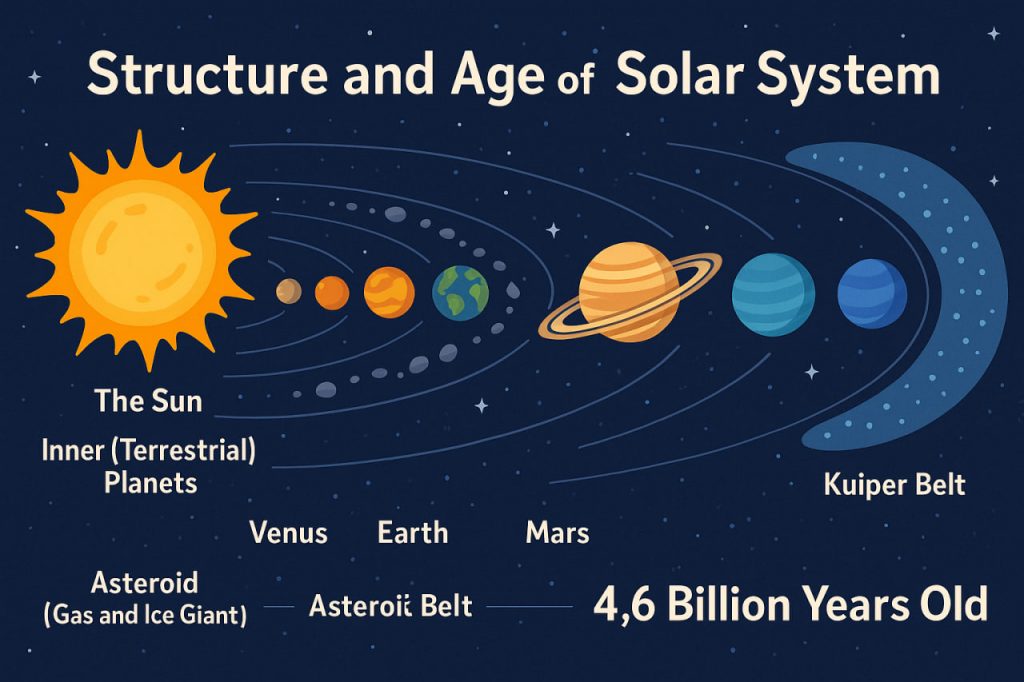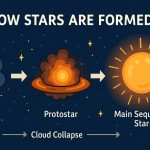The Solar System is a complex and dynamic system of planets, moons, asteroids, comets, and other celestial bodies orbiting our central star—the Sun. It’s our cosmic neighborhood, and its structure and age provide key clues about the origin of Earth and the broader workings of the universe.
How Old Is the Solar System?
Scientists estimate that the Solar System is about 4.6 billion years old. This age is based on:
- Dating of the oldest meteorites
- Radioactive decay analysis of lunar and Earth rocks
- Models of star and planet formation
The Solar System formed from a giant rotating cloud of gas and dust called a solar nebula. Under gravity, this cloud collapsed, forming a dense center that became the Sun. The remaining material flattened into a disk and gradually coalesced into planets and other bodies.
Structure of the Solar System
The Solar System can be divided into several zones:
1. The Sun
- Makes up over 99.8% of the total mass of the Solar System
- A yellow dwarf star (G-type main-sequence)
- Provides light and heat, powering life on Earth and driving space weather
2. Inner (Terrestrial) Planets
- Mercury, Venus, Earth, Mars
- Rocky surfaces, relatively small
- Closer to the Sun and warmer
- Few or no moons
3. Asteroid Belt
- Located between Mars and Jupiter
- Contains thousands of rocky bodies and dwarf planets (like Ceres)
- Remnants of failed planet formation
4. Outer (Gas and Ice Giant) Planets
- Jupiter and Saturn (gas giants): massive, composed mostly of hydrogen and helium
- Uranus and Neptune (ice giants): contain water, methane, and ammonia ices
- Each has many moons and complex ring systems
5. Kuiper Belt
- Beyond Neptune’s orbit
- Home to icy bodies like Pluto, Eris, and many comets
- Source of short-period comets
6. Oort Cloud (hypothetical)
- A distant, spherical shell far beyond the Kuiper Belt
- May contain trillions of icy bodies
- Believed to be the source of long-period comets
Other Key Features
- Moons: Over 200 known natural satellites orbiting planets
- Comets: Icy bodies that develop tails when near the Sun
- Meteoroids: Small rocky or metallic fragments in space
- Solar wind: Charged particles from the Sun that affect space weather and planetary atmospheres
How Stable Is the Solar System?
The Solar System is mostly stable, but it’s still evolving. Planetary orbits change slightly over time, and collisions (especially in the early history) shaped many features. Gravity from large planets like Jupiter helps keep smaller bodies in check but can also send comets toward the inner planets.
Conclusion
The Solar System is a finely tuned system. Its current structure—with rocky planets close to the Sun and gas giants farther away—reflects a long process of cosmic evolution. Understanding its formation and age helps scientists learn about Earth’s history and the potential for life elsewhere.
Glossary
- Solar Nebula: The cloud of gas and dust that formed the Solar System
- Dwarf Planet: A small planetary body that orbits the Sun but hasn’t cleared its orbit
- Kuiper Belt: A region of icy bodies beyond Neptune
- Oort Cloud: A distant, theoretical cloud of icy objects surrounding the Solar System
- Terrestrial Planet: A rocky planet with a solid surface


